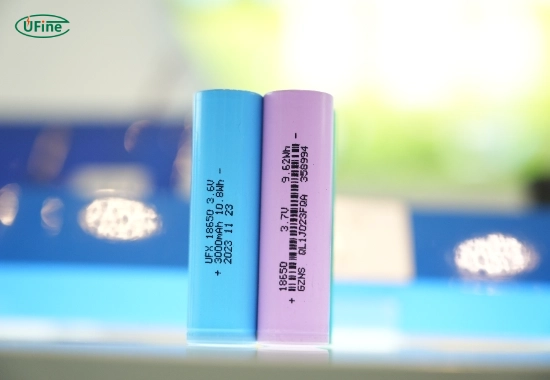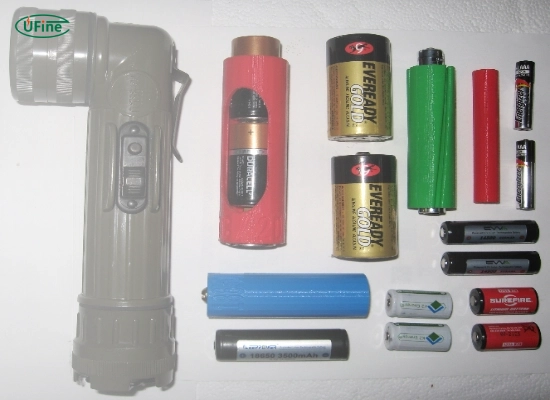Selecting the ideal 18650 flashlight battery necessitates understanding various factors, including performance, compatibility, and longevity. Exploring the nuances of battery types and their suitability for different flashlights is crucial in optimizing functionality. This article delves into the specifics of choosing, maintaining, and maximizing the lifespan of 18650 flashlight batteries to ensure efficient and lasting performance.
Part 1. Pros and cons of different types of flashlight batteries
Pros:
- High Energy Density: Lithium-ion batteries offer a high energy-to-weight ratio, providing longer runtimes for flashlights.
- Rechargeability: They are rechargeable and can endure numerous charge-discharge cycles, making them cost-effective in the long term.
- Low Self-Discharge Rate: Lithium-ion batteries have a relatively low self-discharge rate compared to other battery types, ensuring stored power is retained for longer durations.
- Compatibility: Widely used in modern flashlights due to their compatibility with high-drain devices and various voltages.
Cons:
- Initial Cost: They may have a higher upfront cost than disposable batteries, although their rechargeability offsets this over time.
- Safety Concerns: Improper handling or damage can lead to safety hazards like overheating or even fires, necessitating cautious usage and storage practices.
Alkaline Batteries
Pros:
- Low Cost: Alkaline batteries are economical and widely available, making them accessible to most consumers.
- Availability: Found in numerous stores worldwide, providing convenient replacements when needed.
- Ease of Disposal: They are disposable and can be safely discarded without environmental concerns in many cases.
Cons:
- Performance in High-Drain Devices: Alkaline batteries might struggle to meet the demands of high-drain flashlights, leading to shorter runtimes and reduced efficiency.
- Limited Reusability: They need rechargeable, increasing long-term costs for regular flashlight users.
- Environmental Impact: The disposal of alkaline batteries can contribute to environmental pollution due to their chemical composition.
Nickel-Metal Hydride Batteries (NiMH)
Pros:
- Rechargeability: NiMH batteries are rechargeable, balancing cost and performance for moderate to high-drain flashlights.
- Relatively Environmentally Friendly: They have less environmental impact than other battery types and can be recycled.
- Improved Performance: NiMH batteries often perform better in high-drain devices than alkaline batteries.
Cons:
- Self-Discharge Rate: NiMH batteries have a higher self-discharge rate compared to lithium-ion batteries, leading to quicker power loss when not in use.
- Limited Capacity: They have a lower capacity than lithium-ion batteries, affecting runtime in some high-demand situations.
- Voltage Drop: Their voltage drops as they discharge, affecting flashlight brightness consistently during use.
Part 2. How to choose an 18650 flashlight battery?
Compatibility with Flashlight Models
Ensure the 18650 battery matches the flashlight’s voltage, size, and chemistry specifications. For instance, a flashlight requiring a 3.7V battery won’t function optimally with a 4.2V variant. Compatibility is critical to prevent damage and ensure efficient performance.
Battery Capacity
Evaluate your usage pattern and choose battery capacity accordingly. For instance, a 3000mAh battery lasts longer than a 2000mAh variant. Higher capacity batteries provide extended runtimes if you frequently use the flashlight for extended periods.
Discharge Rates
Opt for batteries with higher discharge rates for high-drain flashlights or those requiring consistent high output. A 10A discharge rate ensures sustained power delivery without voltage drops, which is crucial for maintaining brightness levels in demanding scenarios.
Brand and Quality
Stick to reputable brands known for reliability and safety features in their 18650 batteries. Brands like Panasonic, Samsung, or Sony often provide quality batteries with built-in protections against overcharging, over-discharging, and overheating.
Battery Chemistry Considerations
Assess various battery chemistries like lithium-ion or lithium-polymer. Lithium-ion batteries offer high energy density suitable for most flashlights. In contrast, lithium-polymer batteries might be preferable for custom-shaped or smaller flashlights due to their flexibility.
Part 3. Tips for 18650 flashlight battery maintenance and care
Charging Practices
- Use Compatible Chargers: Always charge your 18650 batteries with chargers designed explicitly for lithium-ion cells. Avoid using incompatible chargers to prevent overcharging or damage to the batteries.
- Avoid Overcharging: Remove batteries from the charger once they reach total capacity to prevent overcharging, which can reduce their lifespan.
- Prevent Deep Discharge: Recharge your batteries before they discharge entirely. Deep discharge can harm lithium-ion batteries, so avoid running them to zero regularly.
Storage Conditions
- Calm, Dry Environment: Store your 18650 batteries in a cool, dry place away from direct sunlight and extreme temperatures. Excessive heat can degrade battery performance and lifespan.
- Protect from Physical Damage: Store batteries in a case or holder to prevent physical damage or short circuits caused by contact with metal objects.
Regular Inspection and Maintenance
- Check for Damage: Inspect batteries for any signs of physical damage, leaks, or swelling. Damaged batteries should be safely disposed of and replaced immediately to avoid safety hazards.
- Clean Battery Contacts: Clean the contacts to ensure proper electrical connections between the battery and flashlight, enhancing efficiency.
Usage Tips for Optimal Performance
- Match Batteries in Pairs: If your flashlight uses multiple batteries, use and charge them in pairs to maintain balanced performance.
- Avoid Extreme Conditions: Refrain from exposing batteries to extreme temperatures, whether excessively cold or hot, as this can impact their performance and longevity.
Part 4. Conclusion
Understanding the type and characteristics of batteries used in flashlights is crucial to choosing the appropriate battery. Choose reliable manufacturers and brands to ensure product quality and performance. By selecting the correct battery, you can ensure your flashlight’s long-lasting use and reliability. As a reliable lithium battery supplier in China, Ufine is committed to providing high-quality flashlight batteries. Our lithium battery products have excellent performance and reliability, providing long-lasting and stable power for flashlights.
Part 5. FAQs
-
Will a flat-top 18650 battery work in a flashlight?
Flat top 18650 batteries can work in flashlights, provided they meet the voltage, current, and size requirements of the flashlight’s battery compartment. -
How do I choose a flashlight battery?
Consider factors such as the flashlight’s power requirements (voltage and current), size compatibility (18650, 21700, etc.), the battery’s capacity (mAh), and its discharge rate to ensure it meets the flashlight’s needs. -
What is the best 18650 battery for a flashlight?
The best 18650 battery for a flashlight depends on the flashlight’s power needs. Still, high-capacity, high-discharge batteries from reputable brands like Sony, Ufine, Samsung, LG, or Panasonic are often recommended. -
How long does an 18650 battery last in a flashlight?
The runtime of an 18650 battery in a flashlight varies based on the flashlight’s power settings, the battery’s capacity, and the flashlight’s efficiency. Higher capacity batteries may last longer, but runtime depends on multiple factors. -
Can I use 21700 instead of 18650 in a flashlight?
It depends on the flashlight’s design and battery compartment size. Some flashlights are compatible with 18650 and 21700 batteries, but others might only fit one specific size. Always check the flashlight’s specifications to ensure compatibility.
Related Tags:
More Articles

LiPo Battery Discharge Rate Guide & Calculation Tips
Understand LiPo battery discharge rates, C-ratings, and how to calculate max current. Essential guide for RC, drones, and electronics users.
High‑Capacity 3S LiPo Batteries: 5000 mAh vs. 10000 mAh
Compare 3S LiPo 5000mAh vs 10000mAh batteries by weight, power, and use. Find the best fit for your drone, RC car, or boat setup.
Top 5 Applications for Small 3S LiPo Batteries
Small 3S LiPo batteries power drones, RC gear, wearables, and robotics with high energy and low weight. Making them ideal for compact electronics projects.
Building and Charging Your Own 3S LiPo Pack: A Step‑by‑Step Guide
Learn how to build, balance, and charge a 3S LiPo battery pack safely at home with this complete DIY guide for hobbyists and beginners.
How to Choose the Right LiPo Battery Plug Type?
Discover the best LiPo battery plug types, how to choose them, and expert tips for safe usage, soldering, and maintenance.





